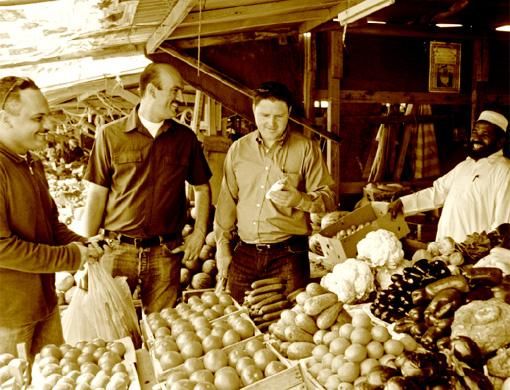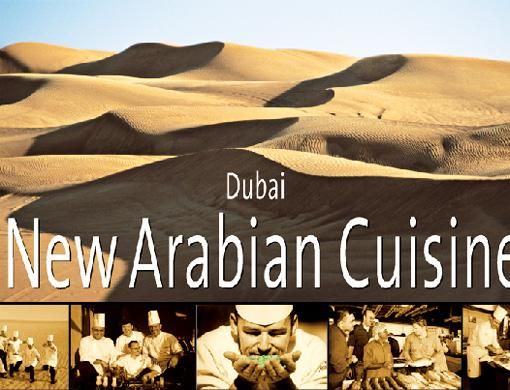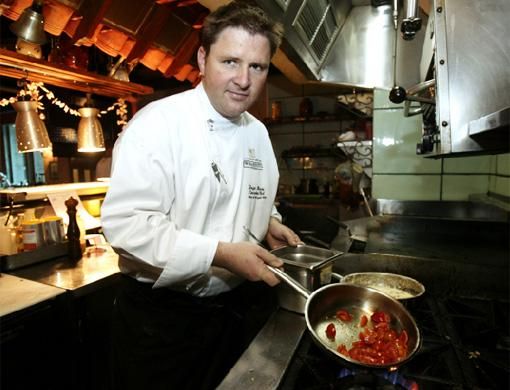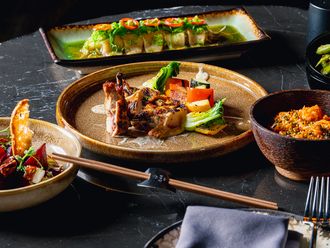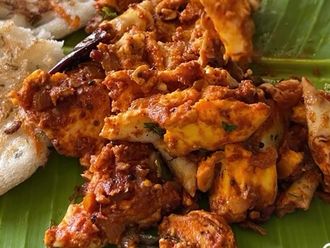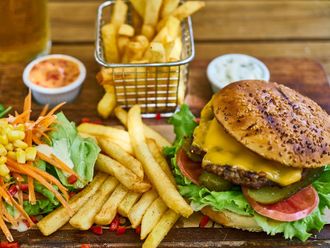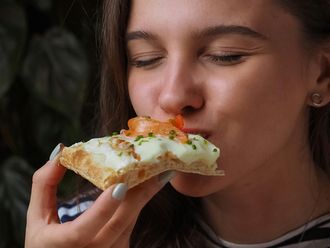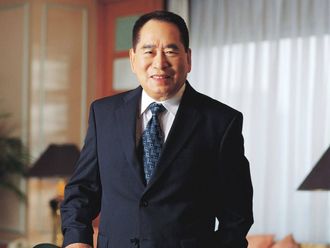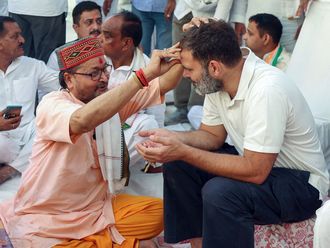It's not just another cookbook on the cuisines of the region. New Arabian Cuisine, the brainchild of Ingor Maass of the JW Marriott Hotel in Dubai and three of his colleagues, offers a lot of extras - on ingredients, the history of well-known dishes ...
It is the quintessential Dubai success story. Man comes to Dubai, gets inspired by the city and makes good. He decides to write a book on it. In this case, 'inspire' and 'execute' a cookbook.
New Arabian Cuisine is no run-of-the-mill success story. Nor is Ingo Maass, executive chef at the JW Marriott Hotel in Dubai and the driving force behind the book, your average Dubai expatriate.
How does a cook book chart out a success story? The answer lies between the glossy eye-catching covers of New Arabian Cuisine (with a 'Dubai' interposed in smaller type above the title).
Ingo Maass is extremely confident that his book - written by German author Lutz Jakel, with inputs from Maass, Christian Jean, Amgad Zaki and Khalil Zakhem, all chefs working with Maass at the Marriott - is "different".
"Even if you consider it from the point of view of the international market (of) French or English cook books, there are quite a few differences in New Arabian Cuisine."
What are the differences? The major one, as the title implies, is the attempt at creating 'new' cuisine, nouvelle Arabian cuisine.
By all accounts, the experiment pioneered by Maass at the JW Marriott, along with his chefs, is a success and may just spark off a new interest in Arabian food.
The beginnings of this Maass attributes to the nine-and-a-half years he has spent in Dubai on and off since the age of 19. And in no small part also to Algeria where it all started.
"I started experimenting with new Arabian cuisine from 1990," says Maass. "(Though) not on a regular basis, it slowly picked up pace. In the beginning I tried it out at some functions, experimented with it when I was in Indonesia but it wasn't until 1996 that I began to take it seriously."
He was in Algeria at the time. "I had a restaurant which served a fusion of Moroccan, Algerian and modern French food and that was where it started happening."
The new Arabian cuisine took centrestage only when Maass shifted to the JW Marriott in Dubai five years ago. "I was asked to cater to a function," he recounts.
"It had to be something special, new and different (from the regular fare). Till then they hadn't tasted or heard about the new Arabian cuisine so we decided to try it out and everybody just fell in love with it. A lot of people even begged us to make it a monthly event. It was very encouraging."
Special functions, cocktail parties and grand receptions at the Marriot ... these all became venues to introduce the new Arabian cuisine. From that success was born the idea of popularising it in the form of a cook book. The only limitation was time.
"Shooting the pictures, setting it all up, writing everything down, double-checking … (But) I knew I could do it," says Maass. "So I was on the lookout for a partner and about three years ago I came across Lutz Jakel, the official author of the book.
"I met him when he was on his first book project called Culinary Arabia to which I contributed two recipes and shot the pictures too. He had been to eight countries in the Middle East to research for the book and since he was educated in Sanaa and Damascus also, he was just the right man for our project."
French chef Christian has been Maass' longtime collaborator, since their time together in Algeria where together they devised the new Arabian cuisine. "Though I developed the concept, Chef Christian was my support, brainstorming and working with me."
Zaki, from Egypt, and Zakhem from Syria, completed the team.
What they set out to do was not only to put new Arabian cuisine on the culinary world map but to also introduce to the world a 'different kind of cook book'.
So we are back to the original question. What's so different about New Arabian Cuisine?
"Most of the books in this genre are aimed at the average housewife. They have poor photo quality, the writing is questionable and most important, they don't tell you the story behind the recipes," says Maass.
"We have brought in a lot of other aspects to this book - it is not only about recipes and how to cook them, it also tells a little bit about the history of Dubai.
"In most cook books by star chefs, there is only one star (the chef); the rest of the team is not important. (In our book) we highlight the fact that this is the result of teamwork, and thus, it's all the richer for it.
"The other difference is that we have given a lot more background knowledge about the food as well as the ingredients used."
Of course, not each and every ingredient's background is highlighted, Maass is quick to point out. "It's not a glossary. But we have explained most of the ingredients we've used and also the not-so-common ones."
What also helps the cook book rise a notch above others of its kind is the running commentary alongside the recipes on life in Dubai, on the various aspects that concern food, with many interesting anecdotes about the culinary teams' exploits in the kitchen and in the souk.
"We have tried to make it very readable, with an element of fun and a fund of small stories," says Maass. "There are so many different stories in the book."
An incident Maass narrates is his discovery of the okra (lady's finger). "It is a very new ingredient in Europe ... they started using it only about 15 years ago. It is actually one of the oldest known vegetables in the world. Over 3,000 years old in fact."
The 'chef's notes' on the dish titled Okra with a Shallot Confit and Balsamic Coffee Sauce elaborates on his experiments with it in 1989 back in Germany, till he finally learnt to cook it the Arabic way in Dubai.
In Maass' version of Beetroot Soup, he reveals the secret of the soup's rich colour. "You cook the beetroot separately in its skin and after it is cooked, do not rinse it. This helps it retain its attractive colour."
Other tips from Maass on soups: "Beetroot soup that has been boiled too long loses its fragrance and acquires a rather musty taste, as is also the case for soups made using fresh herbs.
"We designed the book so you don't just keep it on your coffee table or stick it inside the kitchen book shelf but keep going back to it and each time it says a different thing to you," says Maass.
The photos
Maass is inordinately proud of the photographs used in the book. Justifiably so. The pictures look natural, tempting and not perfected to the point of disbelief as in some glossy cook books.
"We shot everything in sunlight," explains Maass. "No artificial lighting. So we retain naturally bright, vivid colours … we don't believe in falsifying things. Let the food speak for itself!
"If I serve the food to you now it will look exactly as it does in the book. Of course, it made the photo shoots more difficult as food doesn't last very long in the sun."
Another plus for the book is that every recipe is accompanied by a photograph of the dish - something not all recipe books can boast of.
"Every recipe has to have a picture," says Maass. "All professional chefs will include a picture with the recipe because then you can see how it should look and be presented. If you just give the recipes without pictures even (those who cook regularly) would find it difficult."
There are more pluses. According to Maass, "we go the entire range - from the simple to the super-difficult. There are recipes in the book which will be an inspiration for true professionals.
"There are recipes housewives or anybody who loves food will love to attempt. The book will also appeal to people who love to read or even to a tourist who wants to read about Dubai.
"There are things in here that really challenge a professional because the book talks new techniques, different styles of cooking and so on. But there are also some very simple things too. Most cook books by top chefs have just the difficult stuff. We have something for everybody."
Regarding the selection of recipes Maass says they decided on two approaches while putting the book together.
"One, we took traditional dishes (like the simple Egyptian Kushari, for example) and didn't change anything in them. We merely added an ingredient - freshly-grilled salmon - but the rest of the dish is the same.
"And instead of serving it the traditional manner in a big bowl and the five-litre sauce next to it, we dressed it in a small presentable way which really appeals to the eye ... it turns into a piece of art."
Likewise with another dish, Jordanian lentils. "We didn't change it at all, just arranged a little bit of it artfully on a plate, added a shrimp and a small salad. You wouldn't normally eat it like that but we didn't falsify it either. We just try to highlight (the dish's prime qualities) and combine it in a different way."
The second approach, according to Maass, is where they took Middle Eastern ingredients and presented them in a "fine, elegant way so when you see the food it doesn't remind you of traditional Arabian cuisine.
"But when you taste it you will savour the very distinct Middle Eastern flavours of cumin, coriander, garlic, saffron, yoghurt and so on. Traditional ingredients taken to a different plane."
Talking of the design of the book, which as you know in the world of cook books is as important as its contents, Maass says, "When we were designing the cover of the book, as a chef I said I want the dessert to go on it. I wanted a film strip and a picture with a golden hue …"
We have to approach it artistically, he says. If not, just be in the business of feeding people. Which, he hastens to add, is also very important. "Feeding is also an important part of my profession," he says.
"I cook food for about 1,200 people every day and I think it is as important as the new Arabian cuisine, all small and beautiful.
"That's what I love about this profession; sometimes it is very technical and sometimes very arty and other times you have to make sure that the large quantities you cook are very well-seasoned and executed, because if you don't know your techniques 100 per cent, you will not be able to cook for a 1,000 people.''
Knowing ingredients is everything. "Even a simple sandwich can be executed marvellously."
One instance where both the new Arabian cuisine and mass feeding came together was at the Cirque du Soleil, that performed in Dubai recently.
"We served new Arabian cuisine canapés in the VIP tent and about 10,000 guests enjoyed them," says Maass. "So, it was very successful and very alive!"
With the book project behind him, Maass and his team are now looking to expand their new Arabian cuisine repertoire. At present only served at the Marriott's banquets, special functions and in the chef's room, Maass hopes to have a restaurant dedicated to their new cuisine.
"Right now all the restaurants are occupied," he says. "But we are already talking about it. Maybe one day it will happen."
Till then, enthusiasts of new Arabian cuisine can always turn to the book.
(New Arabian Cuisine is available at all outlets of Jashanmal).



